#morphology of the land
Explore tagged Tumblr posts
Photo

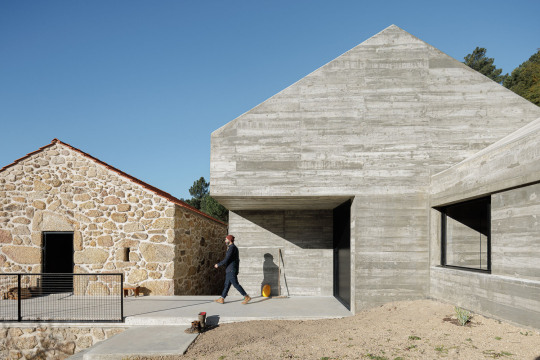
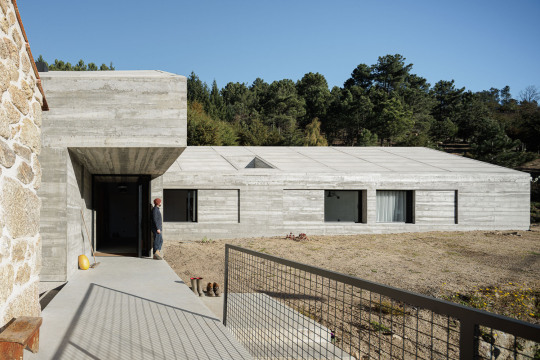
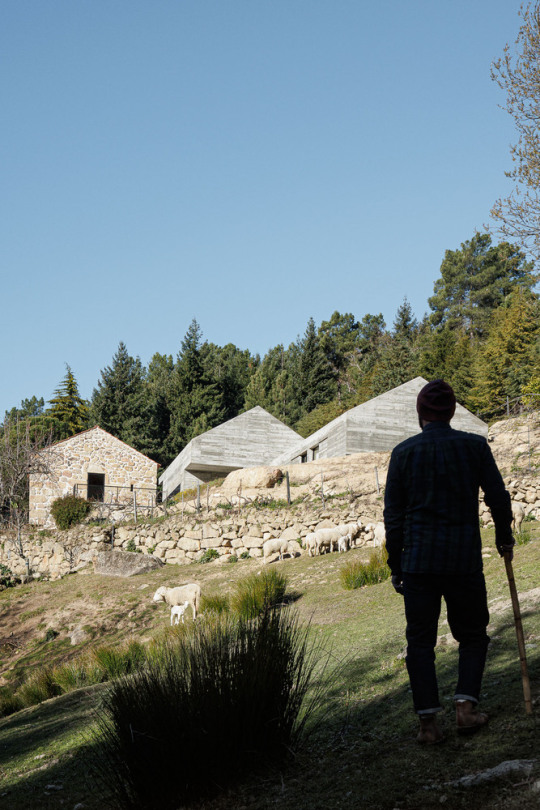

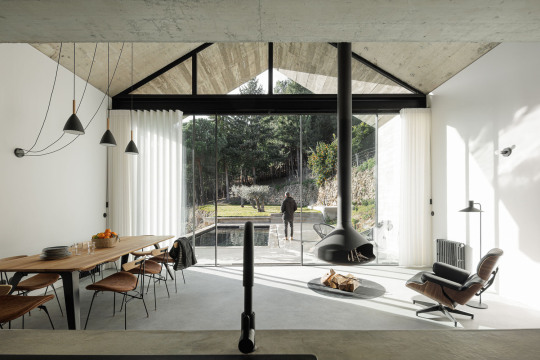
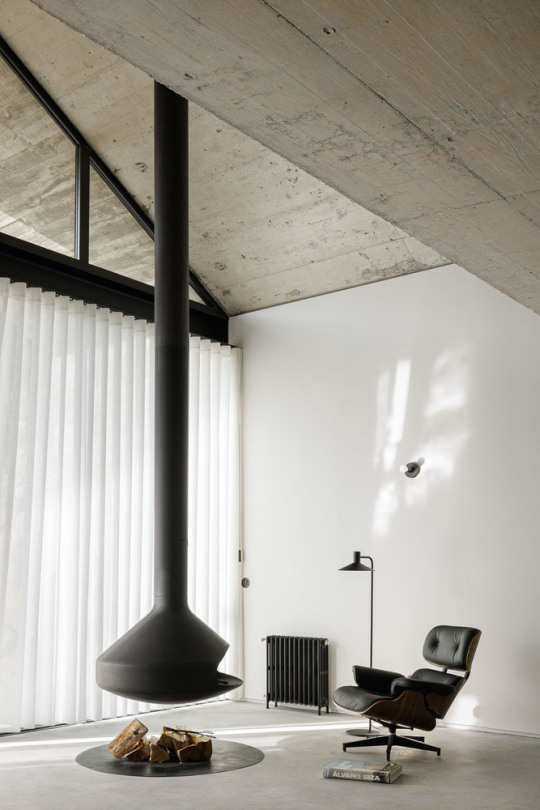
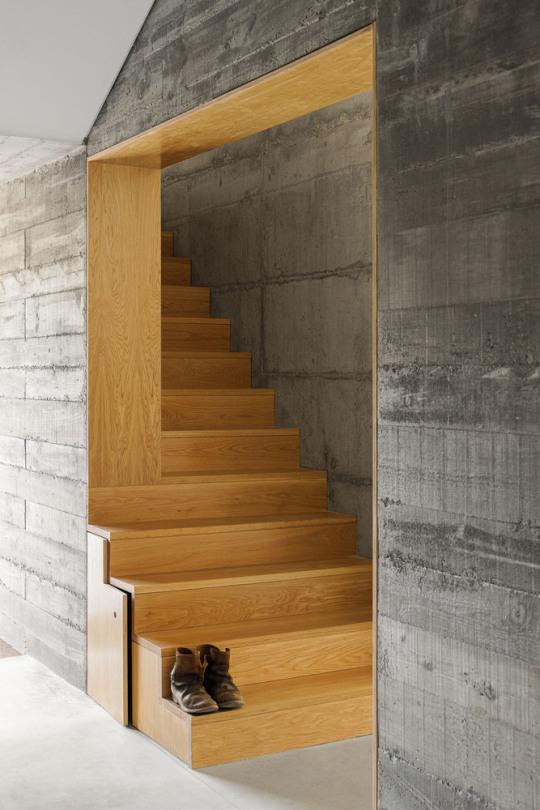
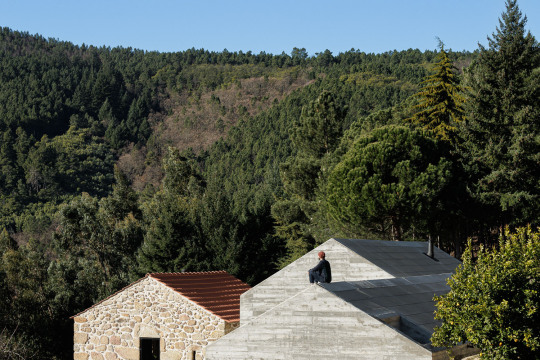

CASA NAMORA
By David Bilo & Filipe Pina
GONÇALO, PORTUGAL
Situated in a natural shelter of a valley at the foot of the Serra da Estrela, close to the parish of Gonçalo, in a place also known locally by the name of Mora, this agricultural property has approximately 18ha of area, and is surrounded by a dense pine tree forest. (...)
The name NaMora has a double meaning in Portuguese. It refers to the location of the project, where “Na Mora” would translate into “In Mora” (Mora being the place where the property lies), but “namora” in Portuguese means literally “flirt” or “date”. (...)
Inside, we sought the neutrality given by the simplicity and purity of the materials and by the illusion of the absence of detail. The idea of interiority translates into openings towards landscapes, frames, and courtyards strategically located.
Read more Archdaily
#Architecture#Gonçalo#PORTUGAL#Mora#agricultural property#pine tree forest#granite built#mid-twentieth century#morphology of the land#characterized by the existence of several terraces#new volumes of concrete were created and implanted in an existing terrace#farm#namora#CASA NAMORA#David Bilo#Filipe Pina#farm’s activities#neutrality given by the simplicity and purity of the materials#openings towards landscapes#frames and courtyards strategically located.
71 notes
·
View notes
Photo

Unknown slug species photographed by Matthieu Berroneau in Tanzania
Had to share this one because it has me wildly confused. Thought it was a sea slug at first, but it’s pretty clearly on land and has all the morphology of a terrestrial slug. I’ve never seen a terrestrial slug with coloring like this and couldn’t find any matches for similar species online. The photographer is usually great at IDing and did not recognize the species. If anyone can find anything, please share!
Photo shared with permission; do not remove credit or re-post!
3K notes
·
View notes
Text

diving shortwings from the northern sea of Siren. this region is far distant from nearly all of Siren's major population centres and is home to descendants of survivors of a historic ultra high tide event. these events are rare and often catastrophic on Siren, caused by the synchronisation of enough of the planet's moons that ten or more are exerting a tidal pull in a single direction. new landmasses and seas will form in the wake of such an event, and in the case of these shortwings, who would normally live within a fifteen minute flight of a coastline, their land was drowned.
Sirenian harpies display a very plastic morphology and are highly susceptible to (comparatively) rapid changes in form over the course of relatively few generations. the seas in Siren are almost all brown and green freshwater, so I thought a colour scheme similar to freshwater salmonids would be applicable, but shortwings are well-known for their astonishing diversity of colour and pattern.
#shoutout to the person in december who asked me about aquatic shortwings and i was like nah idt they exist#even though i had previously SAID there were penguin-like ones. sorry anon u were right i forgor#setting: siren
344 notes
·
View notes
Text
Someone on Reddit asked about a name like "Star Eater" in Valyrian for a dragon and I wanted to share my response here, as well.
*****
If you want my 2¢ on this, names like Star Eater, Moon Racer, Sun Chaser, etc. are good examples of Common Tongue dragon names, but not good examples of Valyrian dragon names. In the Common Tongue (a.k.a. English) it's easy to put together compounds and come up with names. This is much, much less likely to happen in Valyrian. You can do it, but, frankly, it sounds clunky and awkward.
To give you a real world example of this, here are some Song of Ice and Fire names translated into Spanish:
Storm's End: Bastion de Tormentas
King's Landing: Desembarco del Rey
Rattleshirt: Casaca de Matraca
The translators are trying their best, but these translations simply do not (a) convey the sense you get from the English, or (b) come off as natural-sounding Spanish names. This is exactly what you get when you translate things like "Moondancer" or "Dark Sister" into Valyrian.
A more natural way to create a Valyrian name that sounds Valyrian is to start with your target word and embellish it. If you start with qēlos you might get Qēlazmia or Qēlalbrion, both of which might be kind of clunkily translated into English as "Great Star". In truth, there's no way to capture the sense of it with a single word in English because our morphology works differently. You'd have a better shot in Spanish (maybe Estrellona).
If you wanted to translate "Star Eater" literally, it'd be something like Qēlosipradaros. It is quite literally "star-eater", but it doesn't look like a Valyrian name. Think about all the Valyrian names you see in the book—for dragons and people: Daenerys, Aegon, Viserys, Meraxes, Aemon, Aenys, Rhaegar, Jaehaerys, Helaena, Rhaenyra, Daemon… They don't look that big. They don't look like compounds. They can essentially be broken down into three parts: (1) the main semantic content piece, (2) the augment (optional), and (3) the ending. Daemon, for example, looks about as basic as a Valyrian name gets. You have part (1) daem and part (3) -on. We see the ending -on a lot, so we know it's an ending, as opposed to -mon, for example. Daeneryslooks a little bigger, so you have part (1) daen, part (2) -er, and part (3) -ys. That is as big and complex as a Valyrian name gets.
If you look at the list of known dragons, the only time you see the English-y names for dragons are afterAegon's Conquest. And this makes sense. Once they're living in Westeros, the Targaryens start adopting Westerosi customs more and more: their language, their religion, their day-to-day practices... The younger Targaryens are essentially Common speakers that Valyrian as a heritage language. It makes sense that they'd name their dragons in the Common Tongue. There are a still a few Valyrian names mixed in, but that's also to be expected, depending on whether they want to honor their family's heritage or do something new that speaks to them.
In short, it doesn't make sense to render the Common Tongue names in Valyrian as they were never Valyrian to begin with. I'd say if you like the meaning "Stareater", do it in English. If you want a Valyrian name, build it up in a Valyrian way.
#conlang#language#valyrian#high valyrian#onomastics#asoiaf#got#game of thrones#hotd#house of the dragon#song of ice and fire#daenerys#rhaenyra#daemon#viserys#aegon#targaryen
651 notes
·
View notes
Text

The liwe and uraña, the megafauna of the Yutreiya archipelago (a large volcanic island chain near the center of the White Sea, homeland to the qilik-elowey Ulelilwa peoples). These are the two largest native land animals found in these islands, standing about waist high on a human.
The liwe is a flightless bird and the top land-based predator to be found here. Their ancestors were predatory birds who came to occupy niches as land based predators (with some members of the family specializing into insectivorous or partially herbivorous roles). Their wing are entirely vestigial, though retain some use in steering while at chase and in courtship displays- pairs will stand chest to chest and shake their wings at each other, and males will rapidly flap their tiny wings in continued display while mating, which is notably silly looking.
They act primarily as ambush hunters, as they have neither the speed nor stamina to capture a healthy adult uraña in an outright chase. Pairs mate for life and hunt cooperatively, with one typically driving prey to where the other waits in ambush. When hunting large prey, they typically attempt to injure the prey by slashing with their sharp beaks and kill with a crushing/piercing bite to the throat. Smaller prey is kicked and trampled until it can be dispatched with a bite.
The uraña has a superficially deerlike appearance, but is actually a highly derived lagomorph that has specialized in cursorial grazing and browsing niches. Their ancestors were likely hares (or harelike animals) who distributed through parts of the White Sea via rafting events and over land bridges during periods of lower sea levels. They have entirely lost the hopping gait of their ancestors and run like deer, but retain some recognizably hare-like traits. Males competing for access to mates (and females competing for herd dominance) will stand on their hind legs and box each other with their hoof-like claws. They give birth to precocial young (usually two at a time) who can stand and run shortly after birth.
They live in fission-fusion herds of up to 200 (though generally less) individuals for protection against predators. A herd at large is mixed sex, though most interactions outside of the breeding season are homosocial. Females and their young form bands within the interior of the herd, and will drive out adolescent males, while adult and adolescent males form bands that patrol the outside of the herd and watch for predators.
Females maintain strong dominance hierarchies within their circles, maintained with ritualistic displays and brief bouts of boxing. Male bands do not have strong dominance hierarchies, though they compete heavily during the breeding season. Male uraña have two distinct morphs in terms of size and reproductive behavior- larger, higher testosterone males attract and defend harems during the breeding season, and will spend these months tirelessly chasing off competitors, stealing from rivals, and attempting to prevent females from straying, all while barely eating. Smaller, lower testosterone males spend more of their energy courting singular females and/or wooing them out of their harems via shows of strength in boxing matches, attempting to mate with as many as possible during the breeding season without monopolizing access or picking fights with their larger counterparts. Harem males monopolize most of the breeding, but the yearly strain of defending large groups of females often results them having shorter lifespans (or being picked off by predators in a weakened state post-breeding season). Boxing males expend far less energy in the breeding season, and as such often live long enough to sire many offspring throughout their lives. As such, both strategies are reproductively successful and result in/reinforce this distinct morphology.
Liwe were part of a larger family of flightless birds once found on these islands, but the unintentional introduction of rats by the first Ulelilwa settlers contributed to the demise of most of this group (as well as a great variety of flying birds). Liwe eggs are too large and thick shelled for most rats to consume, and they have survived and thrived while the rest of their relatives are extinct on all but the most isolated of islands.
There also used to be a much larger species of uraña (about the size of a key deer). These were the largest animals on the islands and had no natural predators (save for liwe occasionally taking their young). Their population was already under pressure or locally extinct in many islands due to decreasing landmass in rising sea levels, and was fully driven extinct by its grazing lands converted to the raising of crops and ant-farming by Ulelilwa settlers. The smaller uraña occupy more generalist niches and adapted well to these pressures, with most of their populations not only surviving but exploding in size with the gradual extinction of their larger relatives.

(slightly outdated) size ref
413 notes
·
View notes
Text
A Week in Croc News: A ziphodont crocodilian from New Guinea and a "baby" Piscogavialis
Once again I'm here to recap exciting fossil croc news. To give a quick rundown of papers from the last week, we had one on non-semi aquatic adaptations in crocodylomorphs (mostly life on land but also notes of marine groups), a paper that I'm biased toward because it feaures two of my silhouettes in its phylogeny.
The two silhouettes of mine used in the study. Duerosuchus representing the Planocraniidae and Trilophosuchus representing Atoposaurids (eventhough it's not one, it was picked since it at least conveys the right proportions).


Thalattosuchians recieved a lot of attention this past week. For starters, in addition to being brought up in the afforementioned paper, they were given a lot more focus in a study comparing the function and phylogenetic importance of their shoulder girdles (and those of dyrosaurids), a metriorhynchoid skeleton of uncertain affinities from the Cretaceous northeast Italy was described and just today we got a study on the braincase anatomy of Thalattosuchus.
The one paper that excited me the most however was the description of ziphodont crocodilian teeth from the Pliocene Otibanda Formation of Papua New Guinea. To those unaware, ziphodont teeth are essentially teeth that are flattened like a blade and bear serrations along their cutting edge, something seen in dinosaurs, monitor lizards and a select few crocodile groups like sebecid notosuchians, planocraniids and some mekosuchines. Now these teeth are nothing new, they've been known since 1967, hell I even mentioned them on both the wikipedia pages for Mekosuchinae and Quinkana, but they were never properly described...until now.
Leave it to Jorgo Ristevski, Ralph Molnar and Adam Yates to tackle this one, describing not just the ziphodont teeth but also the postcranial material and conical teeth from the formation. Now don't expect any new species or genera. Though valuable, the study doesn't cause any major stirr ups. The ziphodont teeth are tentatively referred to the Mekosuchinae, though they are not morphologically distinguishable from other ziphodont groups like sebecids or the previously mentioned planocraniids, mekosuchines are the only ones that fit the time and location. The other fossils are even more ambiguous, the postcrania referred to Crocodylia incerta sedis and the conical teeth to cf. Crocodylus sp., so basically an unknown crocodilian and a modern croc. This at least suggests that two different crocodiles inhabited Papua New Guinea at the time, maybe even three assuming that the postcrania don't belong to either the ziphodont or conical form.
Since New Guinea and Australia were once connected, forming the continent of Sahul, some Quinkana-like mekosuchines could have easily traveled to the island.


The final thing I want to mention is not an actual study, but still newsworthy. Scientists in Peru just revealed whats thought to be the first juvenile Piscogavialis. An amazingly preserved skeleton was unveiled, preserving much of the skull minus the tip of the snout, most of the spinal collumn until the base of the tail, both hindlimbs and some other bones as well (from the photos theres a few ribs at least).


Whats fun is that though described as a juvenile, the animal is estimated to have already reached around 3 meters in length. To put this into perspective, thats the size of the average female saltwater crocodile and just shy of the 4.3 meters reached by the contemporary Sacacosuchus. Now on the one hand, I think calling that a juvenile might be a bit of an exaggeration (then again the term subadult is arguably vague and meaningless) and I'm curious to see whether or not an eventual study will back this up with anatomical features or if its even possible that it could just be an instance of dimorphism between sexes. But thats just me musing on the basis of a few photos.
Anyways, given that they just state that this 3 meter animal is a "juvenile", you might wonder how large the adult would be?
The short answer...large. Yeah Piscogavialis got big. The skull alone measures over a meter in length and a recent paper on Sacacosuchus said that they grow to nearly twice the length of their smaller contemporary. With Sacaco sitting at 4.3 meters, one could easily imagine Piscogavialis reaching 7 to maybe 8 meters (I should make a proper scaling at some point). Here's how Gabriel Ugueto and artbyjrc scaled this animal and yeah, even if it ate fish it could probably do some real damage if provoked.


#long post#cenozoic#mesozoic#crocodylia#croc#crocodile#gharial#mekosuchinae#prehistory#palaeblr#extinct#piscogavialis#paleontology news#pseudosuchia#crocodylomorpha
99 notes
·
View notes
Text

The Ki lesser owlcat is the smallest species of owlcat. It favours forested areas and is more aboreal than other owlcat species. It takes its name from its range, with mostly coincides with the lands inhabited by the Ki peoples: Uanlikri's equatorial archipelago, Petitwi mountains, and the Huwei, Shuwei, and Ojame archipelagoes.
There are several subspecies of Ki lesser owlcats whose morphology and habits are tailored to their specific archipelago. Mainland Ki lesser owlcats primarily hunt small prey and tend to establish themselves in the territories of larger predators such as jiwi, where there is less competition from other owlcats. The Ojame owlcat is unique in that it preferentially hunts the Ojame Hêtâ, which is larger than itself.
#worldbuilding#art by me#'tober#owlcat#fauna#uanlikri#antiole world#ki lesser owlcat#theropod#speculative biology#speculative evolution#i think this is the last lesser owlcat. probably.#not making any promises really
94 notes
·
View notes
Text
Related to the convergence vs. contingency ask I got a while ago, here's a list of adaptations I'd expect to find on any planet with Earth-like surface conditions and complex (equivalent to Earth's post-Cambrian) life:
Cellular organization, eukaryote-like cells with separated compartments for genome and energy production; large organisms multicellular or at least multi-nucleate
Most energy in the biosphere ultimately from sunlight; most energy is produced in the shorter term by transferring electrons to a strong oxidiser, most likely oxygen
Sex-like recombination of genomes common; most large organisms have a unicellular stage in their lifecycle (e.g. a zygote) and reproduce sexually at least part of the time (and when they do, each individual has two genetic parents); some kind of sexual dimorphism is very common at any given time, at least at gamete level
Most biomass at any given time consists in photoautotrophs, i.e. organisms using sunlight to synthesize organic molecules from scratch; biomass on land is greater than biomass in water, unless land is rare or the colonization of land has not occurred a long time ago
Fractal structure and/or radial symmetry common among organisms that move little actively or not at all; phototrophs have leaf-like light collectors that overlap to form a dense canopy
Bilateral symmetry dominant among organisms that move actively (so, clear distinction between front and back, and between up and down, but not between left and right, especially in outer morphology); sense organs, mouth, and central nervous system concentrated at the front end
Multiple "tree-like" and "worm-like" clades; filter-feeding a very common strategy in water; everything that has to move fast in water is spindle-shaped
Nearly all mobile organisms have long-range chemical, mechanical, and electromagnetic senses (i.e. smell, hearing, and sight), with the respective organs arising independently many times; perception of electrical fields may be common in water but not in air; communication is overwhelmingly vocal and/or visual
Every large organism has some sort of skeletal support; a skeleton based on hydraulic pressure is common in small organisms that move slowly, and a jointed exoskeleton is probably common in small faster movers (hard shells built from carbonates or silica will be popular in water), but the vast majority of largest organisms (say, >1 kg) probably has an internal skeleton
85 notes
·
View notes
Text
Tog morphological biology really is weird. Their mouth, which resembles a crocodilian's, has teeth that imply carnivorous diets. However, where their head is so elongated, their bodies are extremely short and tall in comparison to a crocodilian, which to me suggests that they would have to dedicate significantly more power to holding their head up. Their eyes are positioned in a way that's really only suited to being a prey animal, horse style, unless you're an aquatic hunter. However, togs have the stumpy feet I associate with elephantids or other plains-based ungulates- or hippopotamids. They seem to be perissodactyls in this sense, bearing weight on the front 3 toes. But their shorter bodies paired with these feet would make balancing their heads quite difficult, as they have very little tail to offer a counterbalance, and their feet are stumpy enough to offer very little leverage. On top of that, they're known to be reptilian, but they also exist in cold snowy areas, with adapted colouration even, which suggests they're not cold-blooded. They're overall smooth-skinned (or possibly fuzzy? The striations seem to imply a fuzzy texture but the rest of them doesn't. I hesitate to use the fluffy tog or entagled tog as examples given they're meant to be mutants, but all other entagled creatures' mutations were mostly just exaggerations of pre-exisying traits, so short fuzz -> fluffy isn't that hard to imagine.) but they also seem to have the capacity to grow plated spines, which are modified osseoderms, so they do possess the genetics to grow scales like crocodilians- they just only use it for stegosaurus-style plates on the head and tail. Functionally speaking, these add little value and strike me as either residual anatomy or an in-progress developing adaptation. I lean towards the latter since the plates are a more terrestrial-suited feature.
Basically, lots about their morphology suggests they'd be best suited to aquatic or semiacquatic hunter lifestyles, including the fact that their balance issues wouldn't be as present in the water- except that we only ever see them on land, and their feet would be a nightmare for paddling in water (hippos, who have similar feet and webbing between their toes, are still poor swimmers and just walk along the bottom of water bodies- it's believed the webbing is more for stabilization in bottom walking). So the best explanation is that they were shallow-water hunters who wade, but at some point they became totally land-based, lost some reptilian and aquatic features, started developing spines, and began menacing Lore.
They're just such stupid creatures with stupid nonsense biology. I know this is a land of magic and I have an amulet that channels the power of my love to make my dragon grow gigantic à la Clifford the big red dog, but I draw the line at togs.
#reasons why the togsday war was both heaven and hell for me: got to kill many togs and sate my anger. but had to look at togs.#they're my weird little pet peeve. there are so many other examples of stupid morphology and biology but idc abt those. just togs.#togs are my mortal enemies <3#late nights with ali#ali plays ae#dragonfable#maybe it's cause they're treated as fairly mundane in canon...? I don't think they're looked at as magical#though magic is the best explanation for how they can be Like That and thrive as a species across multiple biomes
39 notes
·
View notes
Text
A University of Bristol study has shed light on how lizards and snakes—the most diverse group of land vertebrates with nearly 12,000 species—have evolved remarkably varied jaw shapes, driving their extraordinary ecological success. This research, led by a team of evolutionary biologists and published in the Proceedings of the Royal Society B, offers a new understanding of the intricate factors influencing the evolution of lower jaw morphology in these animals, known collectively as lepidosaurs. The paper is titled "Ecological drivers of jaw morphological evolution in lepidosaurs."
Continue Reading.
40 notes
·
View notes
Text
Fossil Friday: Daspletosaurus

Before Tyrannosaurus stomped across Montana, another tyrannosaur ruled the roost: Daspletosaurus. Found in the Two Medicine and the Judith River Formations of Montana as well as the Oldman and Dinosaur Park Formations of Alberta, Daspletosaurus was considered a predecessor of Tyrannosaurus.
There are three recognized species that show a transition from Daspletosaurus to Tyrannosaurus. Neat, right? D. torosus is the most basal of the three species. The next most derived is D. wilsoni with D. horneri as the most derived and closest to Tyrannosaurus. Below is a diagram showing the changes in skull morphology.

Daspletosaurus was discovered in 1921 near Steveville, Alberta by Charles Mortram Sternberg, son of Charles Hazelius Sternberg of which the Sternberg Museum of Natural History in Hays, Kansas is named for. Initially, Sternberg thought it was a new species of Gorgosaurus.
In 1970,Dale Russell described and named the fossil Daspletosaurus torosus which means "muscular frightful lizard". Seems fitting.

Daspletosaurus averaged between 28-30ft (8.5-9 m) in length and was about 7.2 ft (2.2m)at the hip. It also had the longest front limbs in proportion to its body of any tyrannosaurid.

There is evidence that Daspletosaurus lived in social groups. A bonebed in the Two Medicine Formation contains remains of a large adult, a small juvenile and an intermediate- (teenager?) sized individual. It could be taphonomic bias but nothing can be ruled out just yet.

Daspletosaurus lived alongside a wide variety of animals including the famous Maiasaura,

Brachylophosaurus,

Coronosaurus,

Albertaceratops,

and even Gorgosaurus.

During the early Late Cretaceous when Daspletosaurus lived, North America was split into two continents by the Western Interior Seaway.

Daspletosaurus lived in Laramidia to the west mostly in the north central reaches (Gorgosaurus tended to be further north). It lived on a vast floodplain with the seaway to the east and the beginnings of the Rocky Mountains to the west. Volcanic eruptions periodically blanketed the land with ash as well.

Tune in Monday to learn about what Tyrannosaurus did not evolve into. Have a good weekend and fossilize you later!
#paleontology#fossils#fun facts#fossil friday#dinosaur#science#science education#prehistoric#daspletosaurus#montana#alberta
20 notes
·
View notes
Text

Leo Triplet Spiral Galaxy M65 - August 12th, 1996.
"Spiral galaxy M65 is a normal spiral galaxy not unlike our own Milky Way. In fact, M65 is a typical spiral galaxy of a type that could be found anywhere in the local Universe. Given a morphological type of "Sa," M65 shows tightly wrapped spiral arms and a large nuclear central bulge. The central bulge stars are older and redder than disk stars, which appear more blue. Stars in the bulge of the our own Milky Way galaxy are also typically older and redder than stars in the disk where our Sun resides. M65 is a member of the Leo Triplet of galaxies, along with its neighbors M66 and NGC 3628. Although it appears that M65's gravity has distorted M66's symmetry, M65's symmetry seems unaffected by M66. M65 is located roughly 35 million light years away, so that light recorded today left after the fall of the dinosaurs but when many land mammals were just evolving on Earth."
50 notes
·
View notes
Note
What do Debu skeleton look like?
Also zebramen/elves.
I am so curious.
Do they have bone????
I wanna gnaw on bone
gimme a Debu bone so I can just go like:

yummy bœn
OH BOY IM SO GLAD YOU ASKED!!!!!!!!!
I ACTUALLY VERY RECENTLY FLESHED OUT THE MAIN BITS
OKAY so first let me go over something small first - evolutionary ancestors of hexapods and octopods
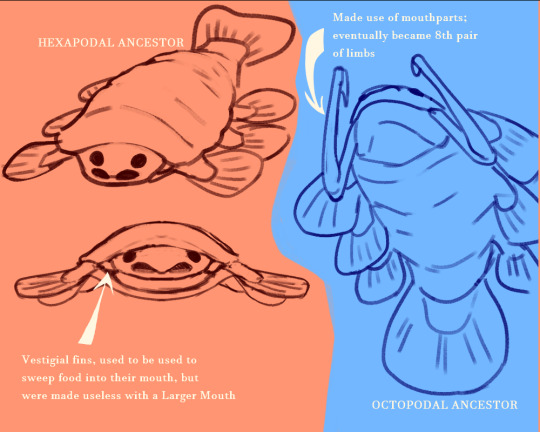
Unlike Earth fish, Bolur fish are flat, horizontal boys, they undulate up and down to swim like cetaceans do. These two are the "lobe finned fish" that became the two clades of hexapods and octopods when they got on land. They're very closely related with the only difference between the "hexapodal" and "octopodal" fish being that the octopods made use of fins that were becoming vestigial - both fish originally had 8 fins with one pair being used to sweep food into their mouths, but most of the members of the family began to lose this pair of fins in favor of this big wide mouth. The octopods instead developed these raptorial limbs out of those fins that would snatch up food, and a lot of early octopodal animals are really damn creepy because while everything else on their body looks archaic, they have this one frontal pair of freakishly developed hands. YUCKY SCARY.
These fish have interlocked plates of bony armor beneath their skin and this still remains, which is why Bolur skeletons look like turtle skeletons - their backbones and ribcages are these sweeping flat plates of bone, with the ribplates being slightly less wide than the backplates to fit beneath it, and their shoulders/limbs usually sitting where the gap is, like this.
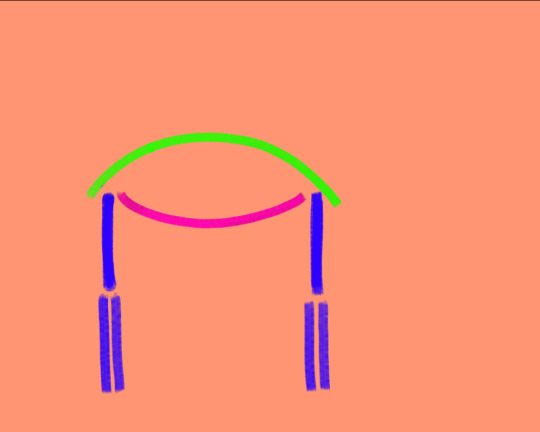
And now that that's out of the way, here's the Debu skeletons first since you asked for them first!
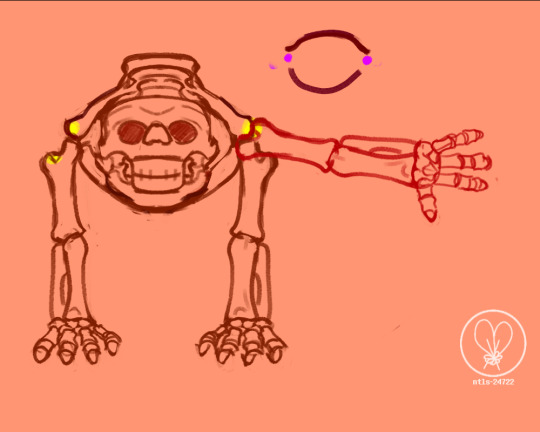
Okay so, I said usually the limbs sit in the ribplate-backplate gap, but that's not the case for Debu because in order to climb, they need more flexibility in the shoulder area. They can't mountain-goat-method cliff-climbing, they're way too big for that - mountain goats are nice and vertical to do it, but debu have gone the different direction and gotten really wide to do it, the backplates where their arms sit under are actually a little less wider than usual so their shoulders have more freedom of movement. Their arms also have a little knob where it touches the backplates both for muscle attachment and to kind of lock the arm (and the debu) into place while climbing.
Their radius's placement is swapped in Bolur but this has no real effect (i wouldn't think so...?), the wrist twists just like ours, so the Debu can climb up walls the same way that DJMM does.
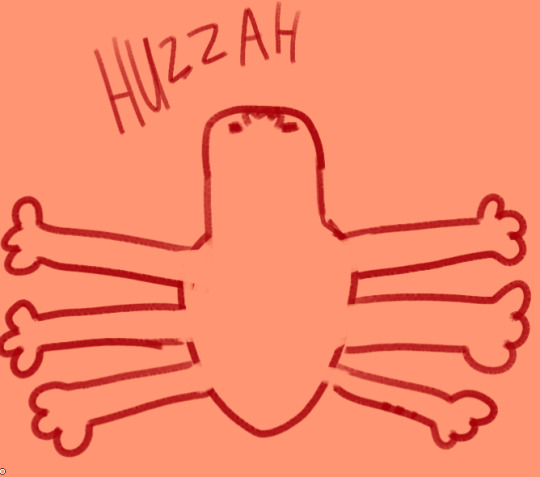
Here's a sideview and how the skin looks over it.
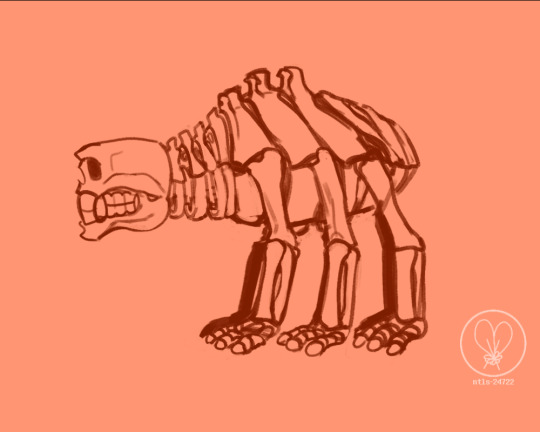
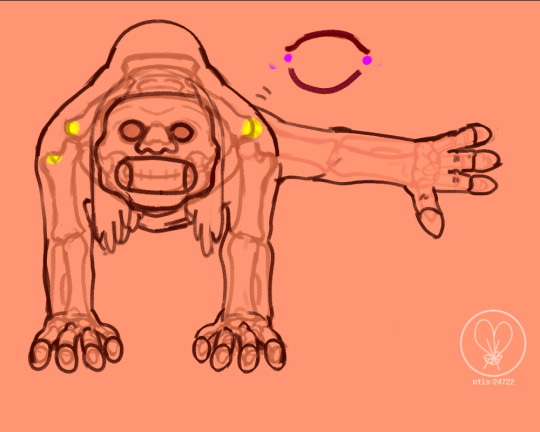
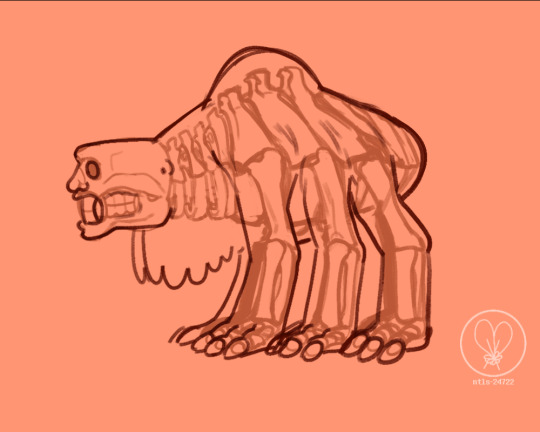
NOW, for the zebraelves, who i thought of skeletons for first
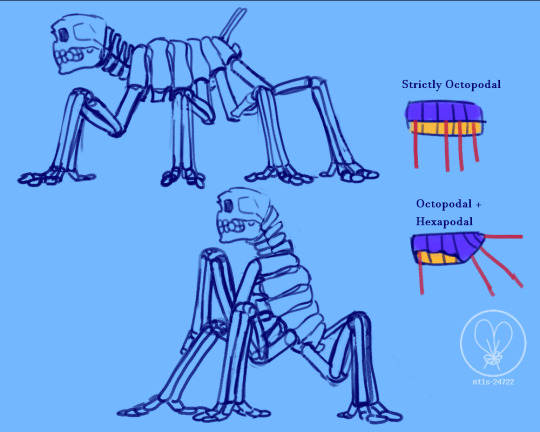
The backplates dont have those.... (rapid typing) spinous processes.... the little things coming out of the back. That's mainly because the Debu had them since their heads were humongous and super damn heavy and needed that place for their neck muscles to attach. Zebraelves and zebramen, not so much. Their heads aren't huge.
What's cool is their arms and "legs" (they are morphologically the same but have varying levels of dexterity) are set up the same way as Debu arms, where they sit at the edge of the backplate rather than between the little gap beneath it... hmm. What was the point of me showing that image at the very beginning, now that i've established that all 3 species deviate from that setup.... whatever
Also, peep the little bones at their butt! They're little bones for keeping their fleshy spinnerets straight just like how earth animals have baculums.
Here's a front view, which also shows the holes between their legs so that all sorts of Stuff can go out of them + Skin. That place is the least protected by bone in zebrapeople, so I guess if you want to kill one go for the ass
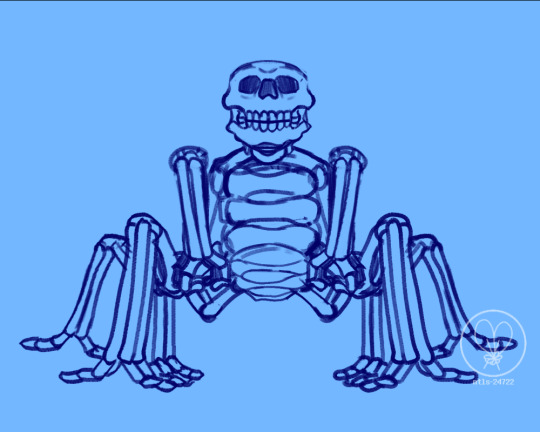
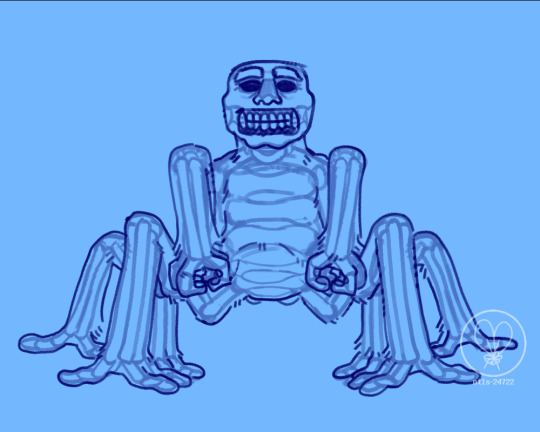
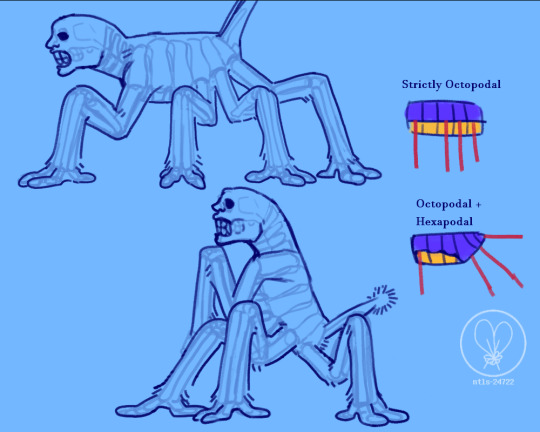
Then there is zebramen!
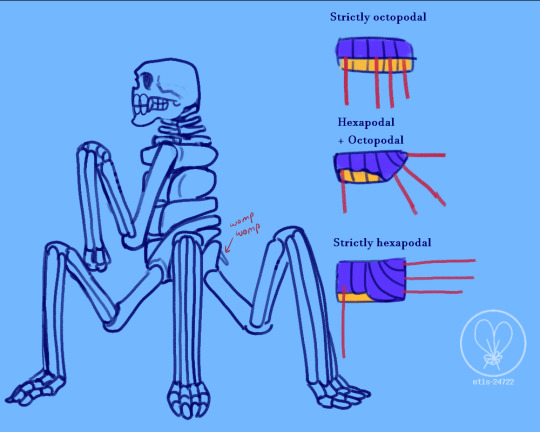
So, as you might notice, the backplates holding the "legs" have slowly pointed more and more backwards in order to facilitate hexapodality, with zebraelves' backplates being diagonal but zebramen's backplates being completely pointed to the back to facilitate permanent hexapodality. Also, the spinneret-culums have almost completely vanished. they're just these sad little pieces of bone that can rotate there like a carnotaurus's arms. I wonder if they spin em around really fast when they're excited.
Anyways. no front view for this one. Because I'm tired and honestly, if you saw the zebraelf one, you could guess how it looks, these 2 are so morphologically similar
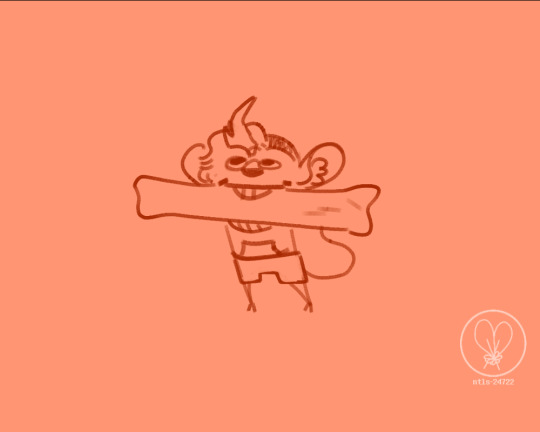
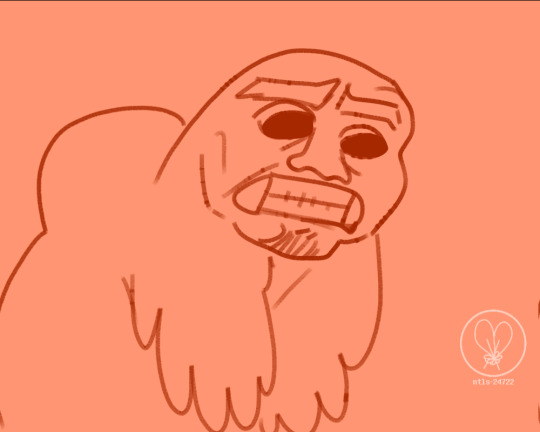
well. hm. your behavior won't get you kicked out but your overenthusiasm sure is enough to freak out the guests at meemaw's morturary cookout
#ntls-24722#djmm#dj music man#speculative biology#speculative evolution#xenobiology#homo mousike#music man#fnaf music man#music man fnaf#artastic-friend#ask#digital
69 notes
·
View notes
Text

finally forced myself to draw the Odd Sirenians i did a poll about aaages ago since askers had them on my mind today lol
of these only the shortstrider is considered to be an actual hybrid, the rest are just natural variations of body shape/type within the same species. except the sea zeta, now so distinct as to no longer be able to hybridise with regular zeta.
i wrote about shortstriders before but their morphology & what traits from either parent will express themselves is completely random. you could have one who almost entirely resembles one parent, or one that looks like a perfect blend of the two, or one with uneven traits like having disproportionally long legs or big wings. most cannot fly, lacking the muscle for it, and also can't hop well either.
inland swamp phocids are the smallest phocids, only a couple of metres long. they live in the shallow water swamps and marshes of the interior western continent. their very impressive plant manes protect their skin from becoming too dry, as they rarely have access to water deep enough to fully immerse themselves. as with other phocids the plants need to be woven in and carefully maintained, but it's far more accessible to these guys because they barely have to do anything to get a nice growth going
river selkies are a similar sort of direction, an inland subtype but for the very dry eastern continent. they live around the few rivers that cross the dry bowl and they are teensy tiny. polar selkies are the largest of their kind.
the longwing is only odd on a technicality; the form is very alike other longwings (tail-less, quadrupedal, four wings etc) but unlike the vast majority these guys can plunge-dive. there is a large population of them in the western coast of the western continent where the sparse land rises into tall cliffs and spires. they do not have to be ultra-light to fly long distances and so can make use of heavy waterproofing oils (applied by hand).
the aquatic zeta is still a marsupial (the fur is short enough to show off the pouch) and still needs to be on land otherwise baby will drown. they do have longer gestation periods than their terrestrial cousins, to minimise the time spent with a baby in the pouch, but when the kid is born they have to haul out and stay out until that baby can swim. they usually pick caves or sheltered lagoons with underwater entrances, in some of the remotest parts of the world. their population is likely only in the few thousands by now.
257 notes
·
View notes
Text
sike yall i'm back.
did i ever post this? if not, merry christmas ig idk
tov lore facts
⋆༺𓆩⚔𓆪༻⋆
there's a deleted scene of her and cara giving each other massages during a spa day. as a result, when she went to train fire magic with alan later on and she set herself on fire, she started to sizzle, causing alan to panic and push her into a fountain. she was not pleased.
cara is a better swimmer than morreial because she spent most of her childhood underwater and, as a result, can fill her lungs with water and stop breathing to switch into her amphibian mode
there's a deleted scene of alan that was too dark to share because it was one of the more cruel things he did to his friends, something he doesn't really do otherwise. he induced a panic attack in morreial by triggering his ptsd in order to get him to reveal some damning information about himself whil he (alan) eavesdropped on his argument (morreial) with his parent's (the jervees). at the end of it, he ends up trying to blame the alter ego when the guilt kicks in, only for the other voice to respond with, "what are you talking about? i told you to leave ten minutes ago.”
he learns to swim from morreial and trusts him like a brother
morreial was my token traumatized character before younger me realized that it is NOT okay to have a token traumatized character. as a result, morreial's trauma responses are more typical of a clinical ptsd diagnosis. interestingly enough, he is the only oc in tov to cope with his trauma in a healthy and productive way, as he canonically goes to therapy
the reasons behind morreial’s infantile memory retention (he remembers being a baby vividly) is explicitly explored and explained in draft 3. every draft afterwards removes the explanation, so you never get the confirmed revelation of how he remembers everything (the basis of his trauma tbh)
i changed morreial’s name six times and at a certain point, at 7am before getting ready for school in the winter, i got frustrated and hyphenated all the names i could remember. hence morreial. just smooshed them all together
morreial was the antagonist of draft 2
there is CANONICALLY a rumour that evan is actually morreial's illegitimate child because of how SIMILAR they are
evan’s love language is making people necklaces and jewellery with the stones he mines
my fav evan arcs ranked:
evan in the rings (eoj)
tc arc (cos)
evan in the north (gotn)
evan, slayer of ividor (soc)
evan of the hollow (lotf)
the timelines and eras of soilaila are as follows:
the zaverenian era
the dragon era
the nainorean era
the cairoyas era
the limious era (aka the era of limiouses)
the transitional era (aka the post-incident period)
the singer era
the word ‘el in galka means “of”. due to the morphological changes to the cairoyas tongue and vocal chords in the beginning of the cairoyas era, the pronounciation of soilaila was originally “soi’el aila,” which means “land of the elemental deities”
there are motifs with the numbers 5 and 7 due to both of those numbers being my favourites (7 more than 5); 5 families of the zaverena, the arcane family being the 5th; the five members of the ____ family; the 5 elemental deities; the 5 heavenly deities; the 12 chapters of the arcanic scriptures (7+5); the 7 eras; the 5 nobility statuses; the 5 branches of hellash; the 5 sins; the 5 stages; the 5 breeds, etc…
people in soilaila are called “cairoyas”, which is a supernatural species capable of magic from the families of soilaila
most people have a specialty magic, but never discover it
the average age to discover one’s specialty magic is 12 years old
the year of nain is a milestone age in cairoyas culture, symbolizing the transition into adulthood and magical maturity (since that is the age in which a person niches into a specific magical family)
a child from parents of 2 different families will only inherit the magic of one, but will be capable of both until their year of nain; after their year of nain, whichever family their specialty magic hails from is their innate dominant family
the original year of nain was 14 years old before i aged it up to 18
the cairoyas do not have last names due to the century naming rule
the century naming rule is the law that states no two people can share the same name in soilaila; everyone must have a unique name and cannot reuse a name until the turn of a new century (i.e. there are no other alan’s that have been born within the last century because the name had to have been reserved only for him during his mother’s pregnancy)
the expecting mark is a temporary runic tattoo expecting mothers / pregnant women receive that support prenatal health of the mother and the child, as well as marks the mother’s eligibility to prenatal services (free healthcare, prenatal nutrition, magical enhancements and support, on-call doctors+midwives, and a reservation of two names per biological genders for the century naming rule)
it is against the law for a pregnant woman to not receive an expecting mark if she chooses to keep the child, as it is considered a form of child endangerment
the end of the limious era was marked by hilbert’s betrayal, as he became the first and only limious to ever lose his title
limiouses get a decade life extension for every year of service
hilbert had been a limious for 60 years before he lost his title, earning him 600 years of extra lifespan
the man to train hilbert into a limious was a man by the name of coze limious
when a person becomes branded as a morregal, their blood turns black, they begin internally bleeding and sometimes even vomit their original blood until it is entirely replaced with morregal blood, and they get an M engraved into their forehead through black magic. the entire process is torturously painful and results in the loss of all cairoyas rights and identity. including one’s name. the original name is conjoined with the brand “gal” (i.e. if a man named sebastian ended up being a gal, they would call him sebagal after his branding)
gal is considered a slur in soilaila, while the full word morregal is criminalized to use unless you are von doro or jer’vazir
minor titles of nobility are often destined through suffixes (i.e. ra, ja) whereas larger titles have their own prefixes or statuses (JQ, JE, J, JV, etc.)
in order to join the military ranks, you must abandon all other titles you possess (i.e. a ja that becomes a member of the military would lose their ja status); this is how raheer ends up losing his ja status and why evan is prohibited from enlisting
in lotf, the soilailan militia operates discreetly under jervee amara’s supervision
the el- prefix is used for nobles who married into their titles rather than earning them; for example, if jervee revenold was not a jervee on his own, but married riyzela and became a jervee through matrimony, he would be called el-jervee revenold instead
the only exceptions to the el- status demotion is with El-Hycan and El-Nooz
inen’s are the title for people capable of becoming a limious, whereas inene’s are inen candidates (remember what i said about the process being more thorough now? they learned from their mistakes lmao)
echoe and myuk are inene’s and should be referred to as echoe ne // echoe-ne and myuk-ne // myuk-ne. despite this, evan only ever refers to them as echoe and myuk
the original reason why evan doesn’t like myuk is because in ditm, she steals from him thinking he wouldn’t notice (he does.)
ditm is the acronym for the blueprint of the entire lotf series, which was originally just one book. it stands for “diamond in the mud” and refers to evan’s sword, which has many parallels with him in that version of the story
ditm was basically an epic because it was cos (cos+gotn) & eoj (eoj+mott) combined
soc’s original premise was meant to take place in the present day. for reference, tov takes place in the 1500s for the human calendar, and lotf takes place in the 1600s. soc’s of plot was set to take place in the 2000s.
ditm was named diamond in the mud as a parallel to evan’s xena sword, which holds a significantly less amount of importance in the lotf series. since the xena sword is a brilliant but violent diamond that blinds anyone that looks at it during its peak reflection, is found in mud swamps in the deep caverns of soilaila’s underbellies, tucked and hidden away, are rare, and incredibly powerful and lethal, it was meant to be a parallel to evan, who was a hidden child created in filth and yet horrifically lethal, beautiful, and powerful. a stone of the gods, as some people called it. and the material of yozar’s sceptre
in draft 3 of tov, caramel’s trauma and its relation to her stealing and illiteracy was more explored as you discovered the reason why she hates the schooling system, steals despite not needing to, and how she uses these survival skills as crutches or coping mechanism to deal with her constant feeling of social insecurity
there’s a deleted scene in draft 3 in which it’s revealed why cara still works a laborious job despite being wealthy (thanks to caramel): she was distributing all her earnings to the abandoned orphans of the vanin ring in order to fund their educations and ensure none of them ended up like her. when morreial discovers this fact, not only does he join her, but drafts up and submits a bill proposal to the jervees to set up publically funded orphanages and schoolings for the orphans who lost their families during the incident. the jervees actually turn down this proposition, which results in a fight between morreial and his parents, the very fight that alan takes advantage of to enter morreial’s mind
draft 3 showcased the preferential treatment alan got over everyone in soilaila by the jervees, including favouritism over their own son (morreial). this is a big reason why draft 3 morreial is so snarky and resentful of alan
draft 2 had a scene where alan and morreial went dolphin riding together and ended up racing each other. alan won, and morreial was pissy for the rest of their trip.
due to the campiness of the draft and the presence of “theatrical morreial”, draft 3 has an extremely quotable scene that i still mention randomly // burst out into to this day. it is when they are walking in a desert, morreial starts cosplaying as a god to prove a point to alan, and then proceeds to point to the skies, trying to beckon rain and thunder (because he’s a water dancer), and yells on the top of his lungs, “let us WALK!” but because it’s a desert and there are no clouds, he gets nothing, and he ended up shamefully putting his arm back down and grumbling at alan to get a move on instead.
the warehouse scene™️ in the og og draft is homologous to the ruins scene in the canon draft of sai, except in that draft, alan allows the dragon to try to fly away before shooting it down (kinda more horrifying when you think about it. he watched it fall to make sure it died after giving it false hope of survival)
in draft 2, alan doesn’t kill à black dragon in the ruins, but he does come back to the villa the next day and kills morreial in front of everyone.
draft 2-4 had a confrontation as the pre-climax scene, where markum, alan, caramel, cara, morreial, and hilbert were all sitting in a room trying not to strangle each other. when von doro joins the conversation, everyone fails and proceeds to jump hilbert
in draft 2-4, morreial’s blood was integral to breaking the magic ban. that’s the reason why von doro wants him so bad (to the point of shattering his mind in the process oops)
#thecomfywriter#tcw lore#tov lore#sai lore#tcw wips#tcw ocs#tov#throne of vengeance#writing community#writing#writerblr#writers blog#writblr#writers on tumblr#wip#writers
18 notes
·
View notes
Note
i know u havent posted about them for a while but did archen gunsmithing get nerfed too? seems like those lil guys have taken nothing but Ls in this current iteration
Yeah it got semi-nerfed but not COMPLETELY nerfed.
Where it's at now is more like they have independently developed gunpowder much earlier and have some explosive devices, but not firearms.
The single biggest threat to archin is vulnerability to much larger predators- a single archin's death doesn't ultimately harm a unit or colony consciousness, but a singular archin IS substantially more important to a colony's survival than a singular non-sapient ant, so devising anti-predatory techniques that limit casualties (rather than the ant-typical strategy of SWARM BITE STING) would be likely. In addition to very advanced and fortified nest building strategies, this is accomplished in domestication of much larger animals for above-ground protection (probably deriving from earlier symbiotic relationships), then possibly experimentation with poisons (especially in that certain natural substances can give off toxic fumes when burnt). A formula for gunpowder could have been discovered in that context (fumes from burnt saltpeter might have already been used as a repellent).
They are very involved in managing land at large scales (and lighting/spreading fires for controlled burns is very hard when you are a collective of inch long bugs), so it would have first been used to start and spread fires. Then used for killing very large animals for food (probably first in the form of strategic fires, then as bombs). Then more refined/more explosive forms could be used in Ant Warfare to produce incendiary devices (mainly to bust open fortified nests or kill en-masse with fire). So like their gunpowder weaponry is closer to dynamite than anything else.
Them having Gun's was kind of a vestigial remnant of them formerly being 2ft tall anthropomorphic bees and like, it would just be an absolutely colossal stretch with their current morphology (as pheromone-based 'hive consciousness' inch-long but otherwise normal ants) for them to develop or see any need for anything resembling a firearm. The way I translated it to their new design was more like "how can I keep the ant guns" rather than "what would sapient ants use as weaponry against larger animals and what natural (or at least Believable) stages of development would bring this about", and I try to use the latter approach as much as possible.
I honestly don't see this as a downgrade though like 'ants with guns' has a wackiness factor I guess but taking the sapient ant collective premise more seriously is a lot more interesting to me.
#I also might be re-setting archin to the one established continent I haven't really done anything with#(Very distant across oceans with basically no contact with the rest of the world- sea travel is by and large not capable of these#distances over completely open ocean. Some caelin might have made it via flight but otherwise nothing)#So it's no longer one very small remnant group but an entire continent mostly peopled by ants and maybe a few caelin groups
42 notes
·
View notes